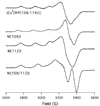Both Met(109) and Met(112) are utilized for Cu(II) coordination by the amyloidogenic fragment of the human prion protein at physiological pH
- PMID: 18778855
- PMCID: PMC2657601
- DOI: 10.1016/j.jinorgbio.2008.07.016
Both Met(109) and Met(112) are utilized for Cu(II) coordination by the amyloidogenic fragment of the human prion protein at physiological pH
Abstract
The prion protein is a ubiquitous neuronal membrane protein. Misfolding of the prion protein has been implicated in transmissible spongiform encephalopathies (prion diseases). It has been demonstrated that the human prion protein (PrP) is capable of coordinating at least five Cu(II) ions under physiological conditions; four copper binding sites can be found in the octarepeat domain between residues 61 and 91, while another copper binding site can be found in the unstructured "amyloidogenic" domain between residues 91 and 126 PrP(91-126). Herein we expand upon a previous study [J. Shearer, P. Soh, Inorg. Chem. 46 (2007) 710-719] where we demonstrated that the physiologically relevant high affinity Cu(II) coordination site within PrP(91-126) is found between residues 106 and 114. It was shown that Cu(II) is contained within a square planar (N/O)3S coordination environment with one His imidazole ligand (H(111)) and one Met thioether ligand (either M(109) or M(112)). The identity of the Met thioether ligand was not identified in that study. In this study we perform a detailed investigation of the Cu(II) coordination environment within the PrP fragment containing residues 106-114 (PrP(106-114)) involving optical, X-ray absorption, EPR, and fluorescence spectroscopies in conjunction with electronic structure calculations. By using derivatives of PrP(106-114) with systematic Met-->Ile "mutations" we show that the CuII coordination environment within PrP(106-114) is actually comprised of a mixture of two major species; one Cu(II)(N/O)3S center with the M(109) thioether coordinated to CuII and another CuII(N/O)3S center with the M(112) thioether coordinated to CuII. Furthermore, deletion of one or more Met residues from the primary sequence of PrP(106-114) both reduces the CuII affinity of the peptide by two to seven fold, and renders the resulting CuII metallopeptides redox inactive. The biological implications of these findings are discussed.
Figures











References
-
- Taylor JP, Hardy J, Fischbeck KH. Science. 2002;296:1991–1995. - PubMed
-
- Fillit HM, O’Connell AW, Brown WM, Altstiel LD, Anand R, Collins K, Ferris SH, Khachaturian ZS, Kinoshita J, Van Eldik L, Dewey CF. Alzheimer Dis. Assoc. Disord. 2002;16:S1–S8. - PubMed
-
- Collins S, McLean CA, Masters CL. J. Clin. Neurosci. 2001;8:387–397. - PubMed
-
- Prusiner SB. Science. 1982;216:136–144. - PubMed
-
- Edkes HK, Wickner RB. Nature. 2004;430:977–979. - PubMed
Publication types
MeSH terms
Substances
Grants and funding
LinkOut - more resources
Full Text Sources
Research Materials
Miscellaneous

